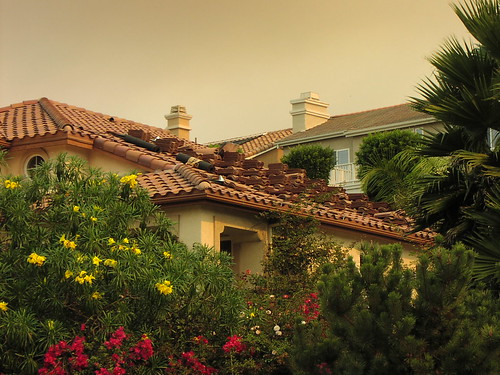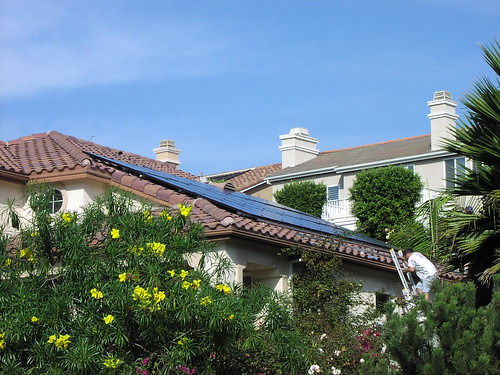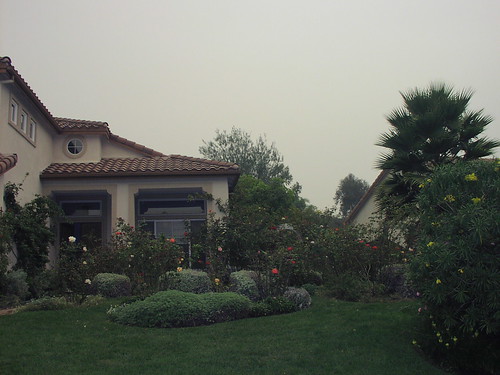Solar power is one of the "alternative" energy sources that someone living in a sunny place like San Diego can make the most headway with. (I put it in quotes because to me, it's just an energy source. There's nothing scurrilously or dangerously or seductively alternative about it at all.)
Here are some construction photos, and a shot from the street.



The solar panels on my house cover most of the southern-facing roofline. You can't really see them from the street unless you stand at a particular angle on your tiptoes. You can see a brief flash of them as you drive by. The neighbors don't really have much of a view of the panels, either, just due to the layout of the nearby houses. The first photo was taken during the worst of the smoke of the October 2003 San Diego County fires. That's why it's orange.
The angle of the roofline almost exactly approximates the ideal angle for catching the most perpendicular of the sun's rays. This was a conscious part of the house-buying process and not a happy accident. Relatively few homes in this particular neighborhood have as good a roofline for solar, but I drive by hundreds and hundreds of homes and businesses every time I'm out that have "wasted" space perfectly aligned to the sun. What a great sight it would be if there were solar panels on rooftops as a matter of course, and not as a rare exception.
The system here is of a "grid-tie" type. That means it's tied to the power grid, as opposed to being "stand alone". Grid-tie means that when we're using less than we generate, the electricity is fed back into the power grid for others to use. It also means that when the electrical grid goes down, so do we. There is a large safety switch that disconnects the solar panels from the system in order to prevent backfeeding.
With the addition of a bank of batteries or a generator to "fake" the grid, then we could convert to stand-alone. However, the reason I didn't choose this option when specifying the system is three-fold.
First, battery banks take up a lot of space and are a cost-adder. Since the power in this neighborhood is extremely reliable, there is little need to incur the space and monetary cost for producing our own night-time power every night. In the case of an emergency (72 hours of no power) then we'd be no better off than anyone else. However, if the power is off for more than three days, the odds of us staying here in Carmel Valley, as opposed to evacuating someplace else, are actually pretty low.
The second reason is that a portable generator is more useful to me than a bank of batteries. The generator can enable stand-alone operation, with the addition of a transfer safety switch behind the generator. The generator power would then be applied at the point where the grid would be if it wasn't down (I haven't tested the whole idea quite yet, so don't go off and do anything drastic without convincing yourself you won't do something epicly dumb first) and can also be taken places (like Field Day) and pressed into service.
The third reason was some concern over maintaining a large bank of batteries for the lifetime of the system. The solar panels have an expected useful lifetime of about 30 years. Some people explain that this is conservative - that many panels in current production may end up with even longer lifetimes. Some of the first solar systems installed in residential places are already over 35 years in use and are still humming along. In stand-alone systems, Batteries are the components with the shortest life expectancy. Most of the companies I talked with said 15 years would be the maximum, but the residential systems I've surveyed required battery bank replacement in 10 years or less.
We did have a failure with one of the two inverters, but it was a quick warrenty replacement. The inverters are under warrenty for 5 years, and are from Sunny Boy. They're old-school big-iron boring old inverters. Batteries (optional), wiring, solar panels, inverters, safety switches comprise the components of a solar system (or photovoltaic system "PV" system for short). There are no moving parts. Electrically, it's quite simple.
The system here at the house was designed for something less than 100 percent of our electric bill. This is commonly done because you're not going to get easily compensated for trying to become a power generation station by the power company, and because of diminishing returns in tiered-power situations. This means that a small system can have more ROI due to the fact that you're knocking your bill down from perhaps a high-cost high-tier power consumption range to a lower-tier lower-cost power consumption range. Getting the power consumption range down to the bottom of the lowest basic tier (e.g. SDG&E basic allotment of the first 300 or so killowatt-hours is only $20 bucks or so) means you're spending a lot on hardware that doesn't really buy you much in terms of financial savings.
Some people design their systems this way, and have relatively small "assist" systems that are very finanically effective, especially if they have high energy consumption due to air conditioning, etc.
I went for a larger system in order to "do environmental good" as well as reduce the electrical bill. The target was 85% of the average consumption over the previous 16 months, as of summer 2003.
The system will pay for itself at a later date due to the higher initial cost, but it sure is nice to get an energy bill of "zero" for 6 months out of the year.
Energy production is lowest in January. Considering that the winter solstice is in late December, it's interesting to see that January, then February, then December are the months where the panels are least effective, at least in terms of energy consumed from the point of view of the power company. This oddity makes sense in light of the fact that grid-tie systems are usually billed by net power.
In other words, in the months where I produce more than I consume, the net "owed" to me is shoved forward to the next month. I get a headstart. This has shifted the entire graph of yearly energy consumption forward a bit. For example, September was a zero consumption month, but March was not. If March and September are both equinox months, then they should have similar energy patterns by the end of the month. But, due to net metering, and the fact that the billing month doesn't exactly line up with the equinox crossover, I guess they don't.
If I was less lazy, I'd take it as an action item to verify this. However, I didn't spring for the expensive frivolous wireless poor-industrial-design data logger (yeah ok I'm a codger), and I don't manually write down how much exactly I generate every month (something the equipment dutififully reports).
I guess I've talked myself into starting to monitor it. Or, I could build my own data logger! Yes, yes, I need another project to do.
That's my experience with solar grid-tie systems.
The state of California, at the time of installation and at the present time, gives tax incentives and subsidies on each kilowatt-hour that your system is rated at. These incentives are not widely publicized. Grid tie systems are offered as an option by at least one developer, but the promotion is somewhat muted, and "energy star appliances" are given higher billing than the solar systems and solar water heating systems that also come with the package.
MY feeling is that once again consumerism has lead to form (appearance) being valued way more than function (clean energy). Solar panels and the equipment necessary to have either a grid-tie or stand-alone system do NOT have to be ugly or obtrusive. There is a false dichotomy at work here that people have totally bought into. Somehow, solar panels are dorky, or ugly. How many times do you actually ponder the south-facing roofline of your house? Do you live on the south-facing roof of your house? Since most installations can in many cases be installed unobtrusively with a bit of intelligent exterior design, and since there are solar panels that look like roof tiles or roof material on the market now, any snobbishness about looks resolves into irrationality.
Yes, the systems add cost to a house. Yes, they can and do pay for themselves directly. They pay for themselves indirectly too, by reducing the need for energy generation at polluting stations, therefore reducing the costs to society of energy production. We don't have a whole lot of natural gas left, either. So the more people that employ solar systems now, the longer the supply will last.
Even the cleanest natural gas burning power generation station still produces pollution that will not be produced by the solar panels. Yes, there is pollution produced in manufacturing solar panels, but that is greatly outweighed by the clean solar power produced by the panels over the course of their lifetime. For each panel, it takes (at the current time) from 2 to 5 years for the electricity produced by the panel to equal the energy that was necessary to produce it. Some people count this energy in their evaluations, and some do not.
There are justifications either way, depending on whether you do a straight household ROI (since everything used in a household is manufactured, and the energy costs of manufacturing are assumed to be in the price to the consumer, adding additional costs is double-billing the item) or you actually want to know whether or not you are making a positive environmental effect (which, in the case of grid tie solar systems, you undoubtedly are, especially after the first few years where the energy required to make the items is paid back by the items themselves. Can you say this about most any other manufactured good?)
Solar systems aren't useful only in the southwest, even though they're most useful here. A photovoltaic system can go in almost anywhere that the sun shines. You may get better performance in a sunny place, and that's where the most activity seems to be, but I've seen systems profiled in places like Connecticut and New York and the UK on television programs, and they seem to work just fine.
The efficiency goes down with clouding, dust on the panels, and lower angle of the sun, but even with these challenges, solar co-generation stations on commercial and residential buildings are a great energy solution. Unlike hydrogen fuel cells, these systems are simple, available now, and easily understood by almost anyone. If you can operate an oven in your kitchen, you are overqualified for operating a solar system on your roof.
Speaking of kitchen ovens, mine is broken yet again.
environmentalism
solar
energy
No comments:
Post a Comment